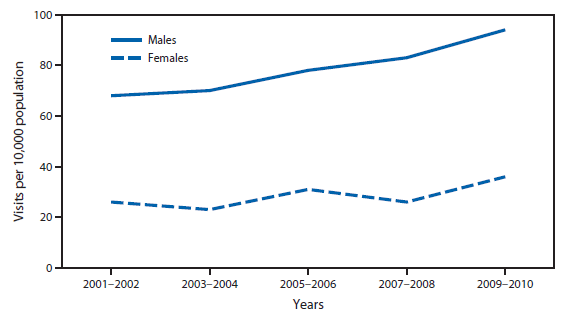Persons using assistive technology might not be able to fully access information in this file. For assistance, please send e-mail to: mmwrq@cdc.gov. Type 508 Accommodation and the title of the report in the subject line of e-mail.
QuickStats: Rate* of Emergency Department Visits for Alcohol-Related Diagnoses,† by Sex — National Hospital Ambulatory Medical Care Survey, United States, 2001–2002 to 2009–2010

* Rate per 10,000 population, based on 2-year annual average. Rates were calculated using U.S. Census Bureau 2000-based postcensal noninstitutionalized civilian population estimates.
† Defined as any-listed diagnosis codes 291, 303, 305.0, 357.5, 425.5, 535.3, 571.0–571.3, and 790.3, and any-listed cause of injury code E860.0 based on the International Classification of Diseases, Ninth Edition, Clinical Modification. Not included are emergency department visits that might be attributed to alcohol use, such as falls, motor vehicle crashes, and other types of injuries/conditions.
From 2001–2002 to 2009–2010, the rate of emergency department visits for alcohol-related diagnoses for males increased 38%, from 68 to 94 visits per 10,000 population. Over the same period, the visit rate for females also increased 38%, from 26 to 36 visits per 10,000 population. Throughout the period, the visit rate for males was higher than the visit rate for females.
Source: CDC. National Hospital Ambulatory Medical Care Survey. Available at http://www.cdc.gov/nchs/ahcd/ahcd_questionnaires.htm.
Reported by: Anjali Talwalkar, MD, atalwalkar@cdc.gov; Farida Ahmad, MPH.
Alternate Text: The figure above shows the rate of emergency department visits for alcohol-related diagnoses, by sex, in the United States from 2001-2002 to 2009-2010. The rate of emergency department visits for alcohol-related diagnoses for males increased 38%, from 68 to 94 visits per 10,000 population. The visit rate for females also increased 38%, from 26 to 36 visits per 10,000 population. Throughout the study period, the visit rate for males was higher than the visit rate for females.
Use of trade names and commercial sources is for identification only and does not imply endorsement by the U.S. Department of
Health and Human Services.
References to non-CDC sites on the Internet are
provided as a service to MMWR readers and do not constitute or imply
endorsement of these organizations or their programs by CDC or the U.S.
Department of Health and Human Services. CDC is not responsible for the content
of pages found at these sites. URL addresses listed in MMWR were current as of
the date of publication.
All MMWR HTML versions of articles are electronic conversions from typeset documents.
This conversion might result in character translation or format errors in the HTML version.
Users are referred to the electronic PDF version (http://www.cdc.gov/mmwr)
and/or the original MMWR paper copy for printable versions of official text, figures, and tables.
An original paper copy of this issue can be obtained from the Superintendent of Documents, U.S.
Government Printing Office (GPO), Washington, DC 20402-9371;
telephone: (202) 512-1800. Contact GPO for current prices.
**Questions or messages regarding errors in formatting should be addressed to
mmwrq@cdc.gov.
 ShareCompartir
ShareCompartir


